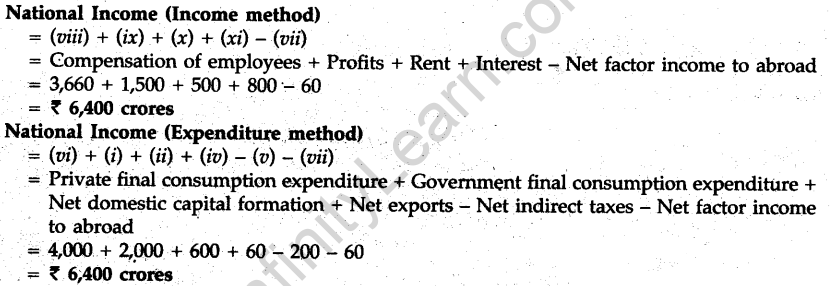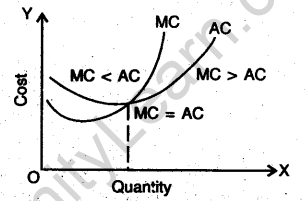Table of Contents
CBSE Sample Papers for Class 12 Economics Compartment Outside Delhi -2012
Time allowed : 3 hours Maximum marks 100
GENERAL INSTRUCTIONS
- All questions in both the sections are compulsory.
- Marks for questions are indicated against each.
- Questions No. 1-5 and 17-21 are very short-answer questions carrying 1 nick each. They are required to be answered in one sentence each.
- Questions No. 6-10 and 22-26 are? short-answer questions carrying 3 marks each. Answers to them should normally not exceed 60 words each.
- Questions No. 11-13 and 27-29 are also short-answer questions carrying 4 marks each. Answers to them should normally not exceed 70 words each.
- Questions No. 14-16 and 30-32 are long-answers questions carrying 6 marks each. Answers to them should normally not exceed 100 words each.
- Answers should be brief and to the point and the above word limit should be adhered to as far as possible.
SET I
SECTION A
Question.1. Define production possibility curve.
Answer. Production possibility curve is the locus of points that indicates such combinations of the two
goods which can be produced by full and efficient utilization of given, resources.
Question.2. Define marginal utility.
Answer. Marginal Utility (MU) is the change that takes place in the total utility when one more unit . of a good is consumed.
Question.3. What is market demand?
Answer. Market demand is the sum of the demand of all the buyers of a commodity at a given price dining a given period of time.
Question.4. Why does average fixed cost fall with increase in output?
Answer. Total fixed cost remains constant and Average fixed cost = Total Fixed Cost/Output
Therefore when output increases -average fixed cost falls.
Question.5. Give the meaning of price elasticity of supply.
Answer. Price elasticity of supply is the measure of degree of responsiveness of supply of a good to a change in its price.
Question.6. Define an economy. Why does it face the problem of ‘how to produce’?
Answer. An economy is a system by which people earn their living. The problem of ‘how to produce’ is the problem of choosing the method or technique of production. This problem arises due to scarce resources and their alternate uses. The problem is whether to use capital intensive technique in which more of capital goods like machines, etc. are used, or to use labour intensive technique in which more of labour is used. This depends on the availability of the factors of production.
Question.7. Explain the distinction between “change in quantity demanded” and “change in demand”.
Answer.


Or
Explain any two factors that affect price elasticity of demand.
Answer. Two factors that affect price elasticity of demand:
- Nature of the good. Generally, the demand for necessaries of life is inelastic because these must be bought even when their prices goes up. Whereas the demand for comforts and luxury goods is elastic.
- Availability of close substitutes. The demand for a commodity will be very elastic if some other substitutes are available. A small rise in the price of such a commodity will induce consumers to use its substitutes. On the other hand, the demand of such commodities is inelastic which have no substitutes.
Question.8. The demand for a good doubles due to a 25 per cent fall in its price. Calculate its price elasticity of demand.
Answer.
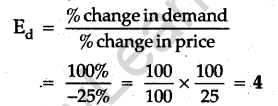
Question.9. Explain the relationship between marginal cost and average variable cost.
Answer. Both Marginal Cost (MC) and Average Variable Cost (AVC) are derived from total variable cost. In the short run, only variable costs change with change in level of output. Thus marginal costs are due to changes in variable costs.
Relationship between MC and AVC can be seen below:
- When AVC is rising, MC is more than AVC, i.e., MC >AVC.
- When MC = AVC? AVC remains constant and is minimum.
- When AVC is falling, MC is less than AVC, i.e., MC < AVC.
All these three points become distinct looking at the given diagram.

Question.10. Price elasticity of supply of a commodity is 1. Its price rises from ‘ 20 to ‘ 24 unit and its supply rises by 300 units. Calculate its supply at the original price of ‘ 20 per units.
Answer.
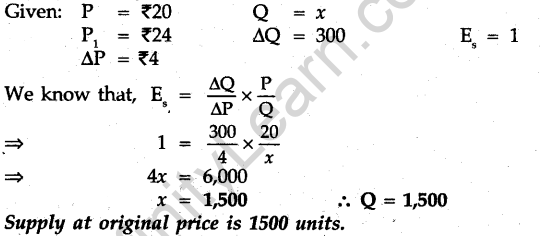
Question.11. Define an indifference curve. State its three properties.
Answer. An indifference curve is a locus of points which represents such combinations or bundles of two goods which give equal satisfaction to the consumer.
Properties of indifference curves. See Q. 15, 2011 (I Delhi).
Question.12. Complete the following table:

Answer.

Or
Explain the conditions of producer’s equilibrium with the help of a numerical example.
Answer. Producer’s equilibrium will take place at a point where marginal cost and marginal revenue are equal. Given below is a schedule of marginal cost and marginal revenue. According to the schedule, at 5 units of output, MR and MC are equal. Therefore it is the point of producer’s equilibrium. Beyond this point MC is greater than MR and hence this cannot be the point of equilibrium.
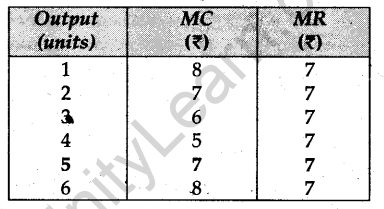
Question.13. Distinguish between behaviour of average revenue of a firm under monopolistic competition and perfect competition. Use diagram.
Answer. Under monopolistic competition, more units of a product can be sold by reducing price. This means AR falls when output increases, In short, AR slopes downwards as shown in diagram (i).
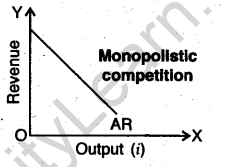
Under perfect competition, any amount of a commodity can be sold at the price fixed by the industry. This means AR is constant when output increases. This means AR will remain constant at all levels of output. As such AR curve will be a horizontal straight line parallel to Y axis as shown in diagram (ii).
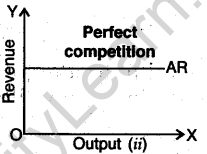
Note: The following question is for the Blind Candidates only, in lieu of Q. No. 13.
Distinguish between behaviour of average revenue of a firm under monopolistic competition and perfect competition using numerical examples.
Answer. AR of a firm under monopolistic competition falls as output increases, for example, if a firm sells 50, units of a good at a price of Rs 5 per unit, the firm will be able to sell more than 50 units only by reducing the price.
AR of a firm under perfect competition is constant as output increases, for example, if a firm sells 50 units of a good at Rs 5 per unit, the firm will be able to sell more than 50-units at the same price of Rs 5 per unit.
Question.14. Giving reasons, state whether the following statements are true or false.
(i) The demand for a good increases with the increase in the income of its buyer.
(ii) If the goods X and Y are substitutes, a rise in price of X will result in a rightward shift in demand curve of Y.
(iii) A budget set is a collection of such bundles of goods that give same satisfaction.
Answer. (i) The statement is false. The demand for only normal goods increases with the increase in income. The demand of inferior goods will decline with the increase in income.
(ii) The statement is true. A rise in the price of X will increase the demand for Y as Y becomes relatively cheaper than X.
(iii) The statement is false. A budget set is collection of such bundles of goods on which the total expenditure is the same and is equal to total income.
Question.15. Explain any two causes of “decrease” in supply of a good.
Answer.
- The supply of a commodity will decrease when prices of inputs increase. This leads to an increase in cost of product. In this case, producer will be able to produce less number of goods with a given amount of capital.
- The supply of a commodity will decrease if there is a increase in the prices of other goods. Because in such a case, firms will start producing more of the other good whose price has increased.
- Taxation policy of the government also affects the supply of a good. Increase in excise ’ duty on a particular good, will lead to an increase in its marginal cost thereby leading to a decrease In its supply.
Or
Explain the law of variable proportions with the help of a total and marginal product schedule. .
Answer. See Q. 15, 2008 (I Delhi).
Question.16. Explain the changes that take place when market price is greater than equilibrium price. Use diagram.
Answer. The equilibrium price is fixed at a point where demand and supply are equal. When market price is greater than equilibrium, there will be excess supply.
As shown in the diagram, equilibrium price is OP. If OP1 is fixed as the market price there will be excess supply equal to FG. This will lead to competition among the sellers. As a result of which price will start falling. Demand will start rising and supply will start falling. Thus, these changes in supply and demand will continue till the price falls to OP at which demand and supply are equal.
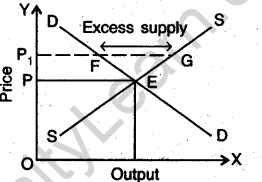
Note: The following question is for the Blind Candidates only, in lieu of Q. No. 16.
Explain the changes that take place when market price is greater than equilibrium price with the help of a numerical example.
Answer. Suppose, the equilibrium price of a commodity is ? 6. At this price demand and supply are equal. Suppose, the price goes up to Rs 7. At this price, supply will increase as producers will like to sell more units and die supply will be more than the demand which will decline further. In other words, there will be excess supply. This will lead to competition among the sellers and the price will come down. As a result, demand will start rising and supply will start falling. These changes will continue till the price falls to ? 6 at which demand and supply are equal.

SECTION B
Question.17. What are demand deposits?
Answer. As the name suggests, these: are the deposits which can be withdrawn from the bank on demand.
Question.18. Define money.
Answer. Money is anything that serves as a medium of exchange and is universally acceptable.
Question.19. Give the meaning of inflationary gap.
Answer. The excess of aggregate demand over aggregate supply at the full employment level, is inflationary gap.
Question.20. If the value of marginal propensity to save is 0.4, what will be the value of investment multiplier?
Answer.

Question.21. What is a government budget?
Answer. A Government budget is a statement of expected receipts and expected expenditure of the government during a financial year.
Question.22. Distinguish between intermediate goods and final goods. Also give examples.
Answer.

Question.23. What changes will take place in the economy when aggregate demand is less than aggregate supply? Explain.
Answer. At equilibrium level in an economy, aggregate demand will be equal to aggregate supply. However, when aggregate demand is less than aggregate supply, this will leMTto increase in inventories and as a result of this, producers will produce less and aggregate supply will fall. These changes will continue till the aggregate demand and aggregate supply are equal. In other Words, aggregate demand and aggregate supply have to be equal.
Question.24. In an economy 20 per cent fall in investment results in 40 per cent fall in income. Calculate the value of the marginal propensity to consumer.
Answer.

Question.25. Distinguish between revenue deficit and fiscal deficit.
Answer. Revenue deficit refers to the excess of total revenue expenditure over total revenue receipts. On the other hand, fiscal deficit refers to the excess of total expenditure over total receipts excluding borrowings during a fiscal year.
Revenue deficit ==Total revenue expenditure – Total revenue receipts
Fiscal deficit = Total budget expenditure – Total budget receipts excluding borrowings
Or
Fiscal deficit = Total budget expenditure – (Revenue receipts + Non-debt capital receipts)
Or
Distinguish between direct tax and indirect tax. Give one example of each.
Answer. See Q. 28, 2012 (Comptt I Delhi).
Question.26. List the items included as invisibles in the balance of payments account.
Answer. The following items are included as invisibles in the balance of payments account:
- Export and import of services.
- Transfers from and to abroad.
- Income from and to abroad.
Question.27. Complete the following table:

Answer.

Question.28. Explain the ‘price stability’ function of a government budget.
Answer. An important function of the government budget is bringing about price stability. Price stability signifies that there should not be fluctuations or variations in the prices. The : Government can check price fluctuations through its expenditure and taxation policy. During inflation, it tries to reduce aggregate demand by reducing government expenditure and raising taxes. During period of falling prices, it tries to increase aggregate demand.
Question.29. Explain why there is an inverse relationship between price of foreign currency and its demand.
Answer. When price of foreign currency increases, imports from that country become costlier, for example, when the price of US $ increases, home buyers (say, Indians) have to pay more for buying the same volume of goods from America. As such home buyers will import less foreign goods. This means the demand for imports falls and this leads to a fall in the demand for foreign currency.
Similarly, when price of a foreign currency falls, imports from that country become cheaper. So imports increase and demand for foreign currency rises.
Or
Explain the effect of rise in price of foreign currency on exports.
Answer.When price of a foreign currency rises, foreigners can buy more goods from the home country by spending the same amount of their currency. For example, If the price of US $ increases, Americans get more goods from India by paying the same amount of their currency. In other words, exports become cheaper and hence exports increase.
Question.30. How will you treat the following in the calculation of Gross Domestic Product of India? Give reasons for your answer.
(i) Profits earned by a branch of foreign bank in India.
(ii) Salaries of Indian employees working in embassy of Japan in India.
(iii) Salary of residents of Japan working in Indian embassy in Japan.
Answer.(i) Profits earned by a branch of foreign bank in India will be included in the domestic product of India as the foreign bank is located within the domestic territory of India,
(ii) Salaries of Indian employees working in embassy of Japan in India is not a part of domestic product of India because Embassy of Japan in India is not a part of domestic territory of India.
(iii) Indian Embassy in Japan is a part of domestic territory of India, therefore salaries paid to the residents of Japan working in Indian Embassy is a part of domestic product of India .
Question.31. Explain any two functions of central bank.
Answer. See Q. 25, 2009 (III Outside Delhi).
Or
Explain any two functions of money.
Answer. See Q. 27(Or), 2009 (I Outside Delhi).
Question.32. From the following data calculate Gross National Product at Factor Cost by (i) income method, and (ii) expenditure method.
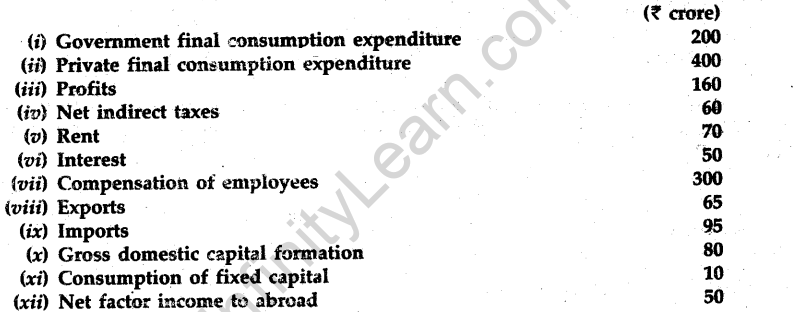
Answer.


SET II
Note : Except for the following questions, all the remaining questions have been asked in Set-I.
SECTION A
Question.8. When the price of a good falls by 10 percent, its demand rises from 200 units to 220 units. Calculate its price elasticity of demand.
Answer.

Question.9. Explain the relationship between marginal cost and average cost.
Answer. Average Cost (AC) and Marginal Cost (MC) are both derived from total cost. MC bring about changes in AC. When MC falls, it pulls down AC and when MC rises, it pulls AC up.
This becomes clear by looking at the following points:
- When MC is less than AC, AC falls.
- When MC = AC, AC is constant arid at its minimum.
- When MC is more than AC, AC rises.
These points become evident looking at the diagram.

Question.10. At a price of Rs 10 per unit, the supply of a commodity is 300 unite. Its elasticity of supply is 1.5. Its price increases by 20 percent. Calculate its supply at the increased price.
Answer.

SECTION B
Question.24. Marginal propensity to consume is zero, Calculate the change in income if investment falls by Rs 1,000 crores.
Answer.
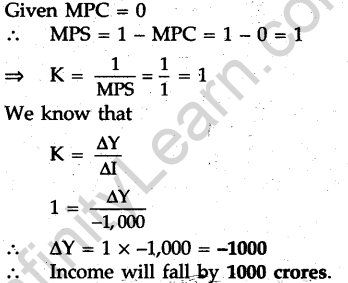
Question.27. Complete the following table:

Answer.

Question.28. Explain the basis of classifying government expenditure into revenue and capital expenditures.
Answer. The basis of classifying government expenditure into revenue expenditure and capital expenditure is the fact as to:
- whether an expenditure either creates an asset or reduces a liability. If it does, it is a capital expenditure;
- whether an expenditure neither creates an asset nor reduces a liability. If an expenditure neither creates an asset nor reduces a liability, it is clarified as revenue expenditure.
Question.29. Explain why there is an increase in supply of foreign currency when its price rises.
Answer. When the price of foreign currency, say, US $ has increased in terms of domestic currency, say, Indian Rs , i.e., from 1 dollar = Rs 54 to 1 dollar = Rs 56, this makes home country’s goods cheaper to the Americans because 1 dollar can now purchase Indian goods worth Rs 56 instead of Rs 54. This would induce America to import goods from India. Indian exports will increase, as a result/ supply of foreign exchange, i.e., US dollar will rise. Thus a rise in the price of foreign currency leads to an increase in its supply.
Or
Explain why there is an increase in demand for foreign currency when its price falls.
Answer. There is an inverse relation between price of foreign exchange and the demand for foreign exchange (say US $) in terms of domestic currency (say Indian Rs ). This means lower the price of foreign exchange, the higher is the demand for it. When price of foreign currency falls, imports from that country become cheaper. Imports increase and therefore demand for that currency increases. It can be explained further taking a concrete example. Suppose the present price of US dollar is Rs 55. This means for buying goods worth 1 US dollar from America, India has to part with Rs 55. Suppose the price of US dollar falls to Rs 50 a dollar, now India will part with Rs 50 to buy goods of the value of one US dollar. Thus, Indians will import more from America and will demand more US dollars.
Question.32. Calculate National Income by (i) income method and (ii) expenditure method from the following data:

Answer.
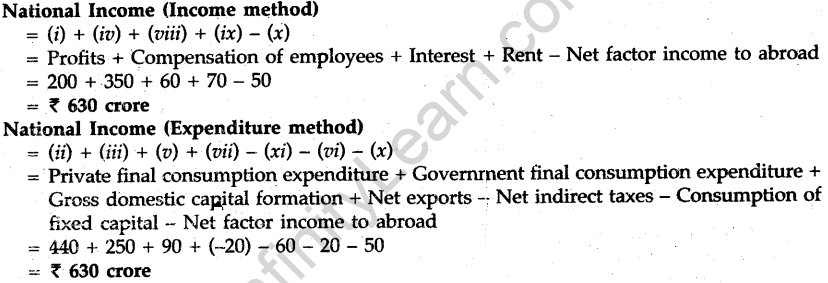
SET III
Note: Except for the following questions, all the remaining questions have been asked in Set-I and Set-II.
SECTION A
Question.10. As a result of 20 percent fall in the price of X, its supply falls from 500 units to 450 units. Calculate its price elasticity of supply.
Answer.

Question.13. Explain the implications of the following:
(i) Large number of sellers and buyers under perfect competition.
(ii) Interdependence of firms under oligopoly.
Answer. (i) Under perfect competition, the number of sellers and buyers is very large. The number of sellers is so large that output by an individual seller is an insignificant proportion of the total output of the industry. Hence an individual seller cannot influence the price of the commodity on its own.
The number of buyers is so large that an individual buyer’s share in the total purchase is so negligible that no buyer can influence the price on its own.
(ii) Under oligopoly, there is interdependence of firms in case of price-output decisions as ‘ no firm can take such a decision independently. Interdependence implies that each firm takes into consideration the likely reactions of the rival firms before taking any decision – . about the change in the price and output.
Question.16. Explain the changes that take place when market price is less than equilibrium price. Use diagram.
Answer. The equilibrium pricey of a commodity is fixed at a point where its demand and supply are equal. If market price is less than, the equilibrium price, it creates a situation of excess demand. This means at this price, demand will be more than the supply. As shown in the diagram, if the price OP (equilibrium price) becomes OP1 (less), there will be excess demand equal to FG, the gap between demand and supply. This will lead to competition between the buyers. As a result price will start rising. Because of the increase in price demand will start falling and supply will start rising. These changes will continue till price becomes equal to OP at which demand and supply are equal.
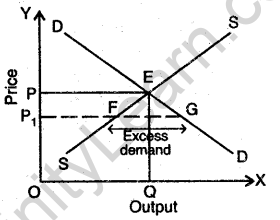
Note: The following question is for the Blind Candidates only, in lieu of Q. No. 16.
Explain the changes that take place when market price is less than equilibrium price, with the help of a numerical example.
Answer. Read the above answer and add:
Suppose the equilibrium price is Rs 5 at which demand equals supply. Further suppose that market price falls to Rs 4. This will lead to excess demand and competition between the buyers. As a result demand will start falling and supply will start increasing. The changes will continue till price rises to Rs 5 per unit at which demand equals supply.
SECTION B
Question.21. Give two examples of capital receipts in a government budget.
Answer. (i) Loans raised by the government from public, from RBI and from abroad.
(ii) Funds raised by way of disinvestment, i.e., assets sold to private enterprises.
Question.22. Explain the circular flow of income.
Answer. See Q. 22, 2012 (Comptt. I Delhi).
Question.24. In an economy, income increases from Rs 5,000 crore to Rs 6,000 crore as a result of 20 percent increase in investment. Calculate the value of investment multiplier.
Answer.

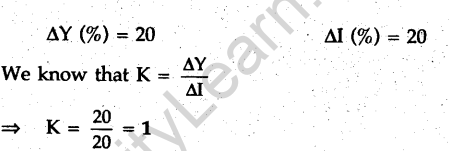
Question.27. Complete the following table:

Answer.

Question.32. Calculate National Income by (t) income method and (ii) expenditure method from the following data:
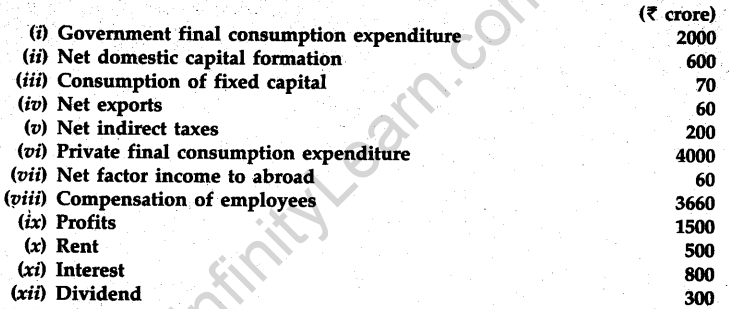
Answer.
